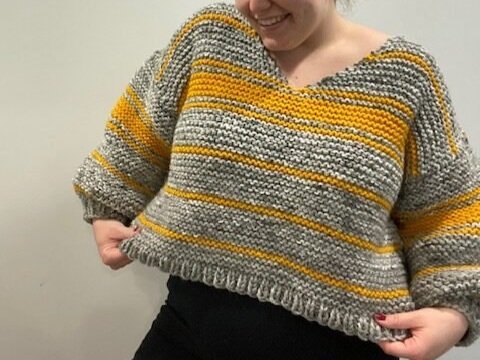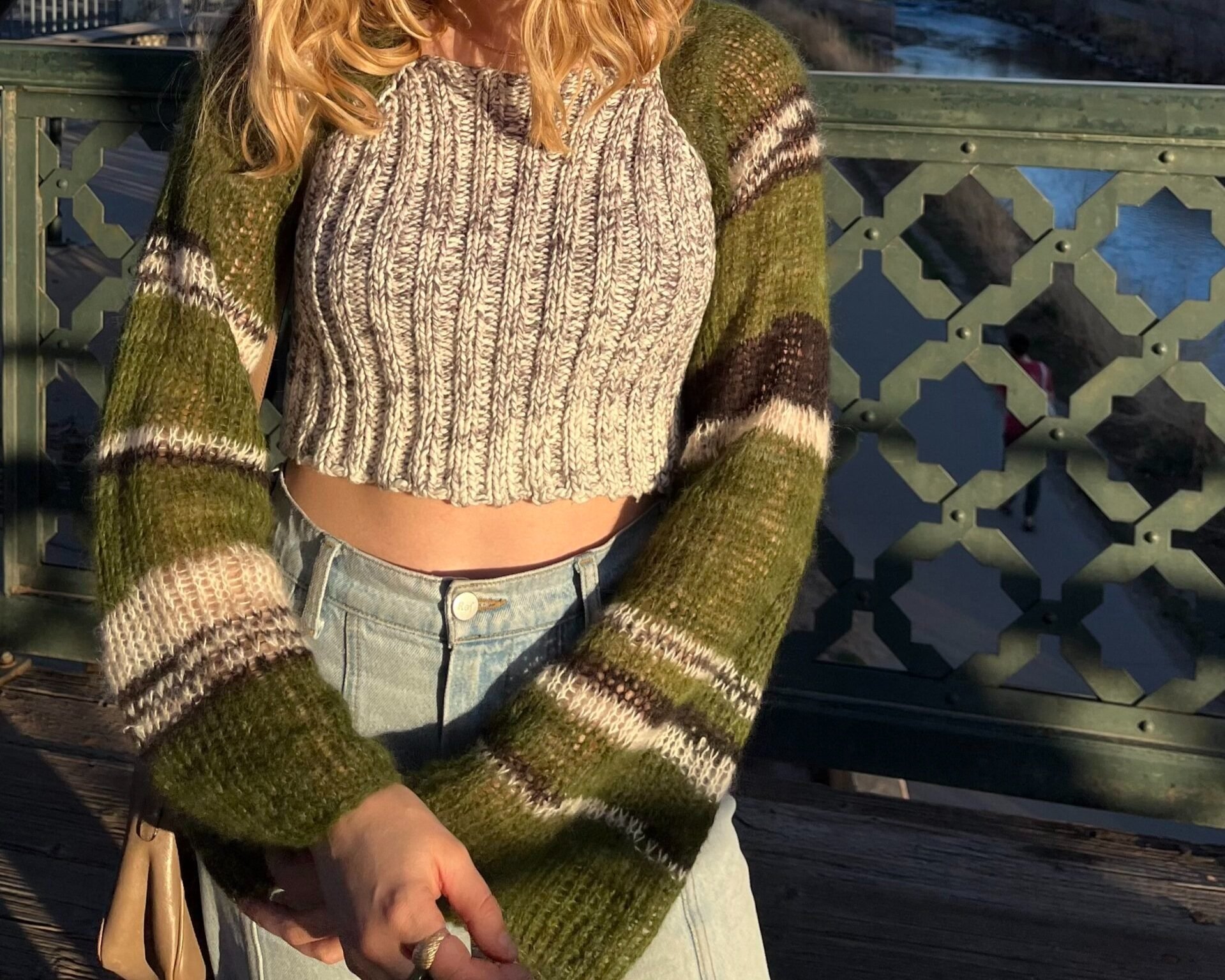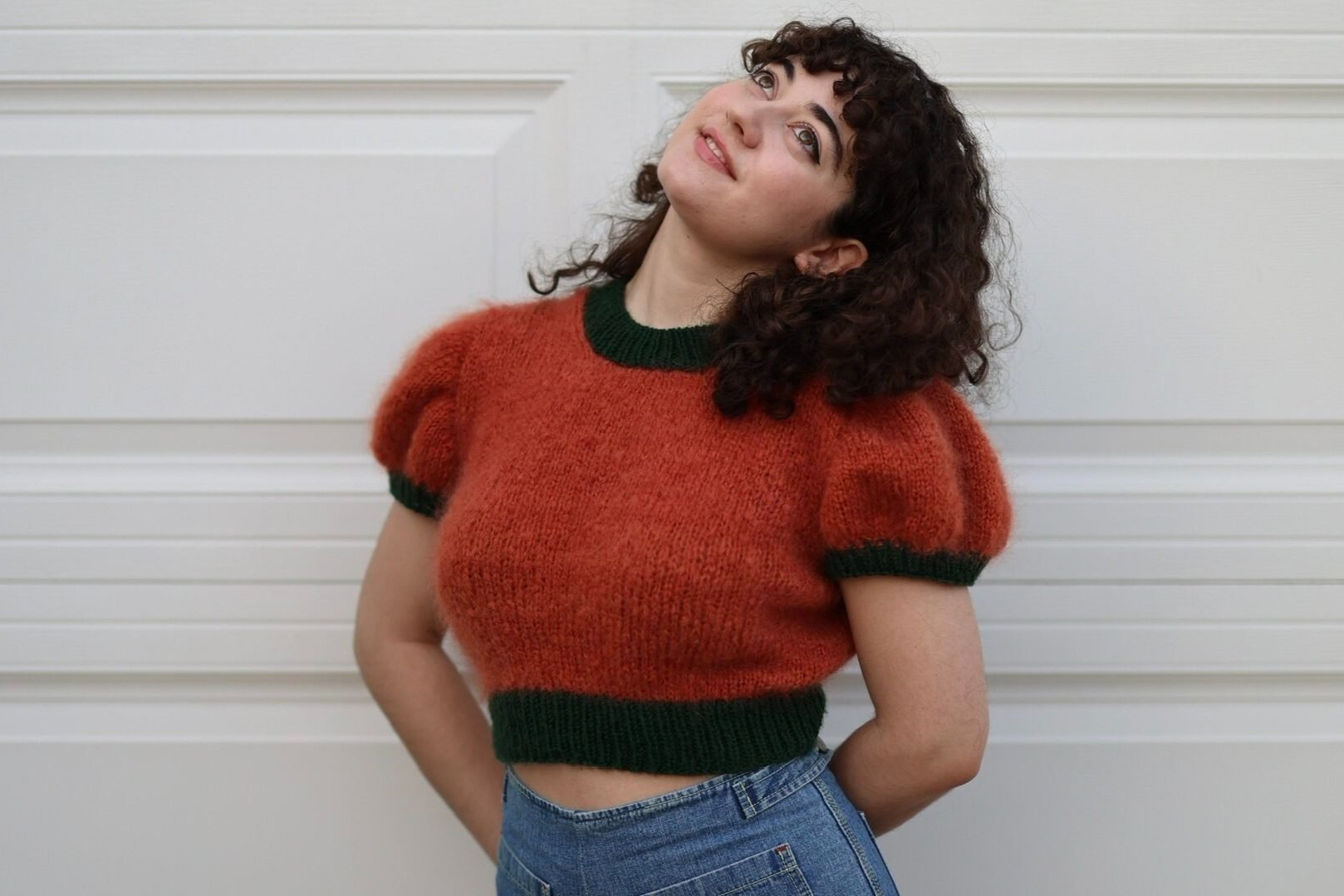Advice for First Time Knitting Pattern Designers
Are you thinking of designing knitting patterns, but are feeling intimidated by the design process? You’re not the only one. I’m working on my first pattern right now and making the sample pattern alone is challenging enough, but then also grading, finding a tech editor, managing test knitters, and so on… it can be a bit overwhelming. In this blog post, you will hear tips from designers on how to get started on your first design process, plus some simple steps to launch your first pattern! By the end, you’ll have enough encouraging advice and helpful information to push your anxieties aside and make your first awesome knitting pattern.
Knitting Pattern Creation Tips from Knitwear Designers
As I have been working on my first ever knitting pattern, I’ve had a few questions about test knitting, sizing, and tech editing that keep circling my brain. And as they were circling, I couldn’t help but wonder how many other first time or aspiring knitwear designers have asked these questions themselves.
One course of action is to just learn through trial and error and figure it out as I go. However, I’m someone who really likes to research and know what I’m getting myself into (go figure). So instead of diving into the trial and error plan, I decided to ask designers to share tips and advice for newbie designers or for people who are simply contemplating making a knitting pattern. Here is what some amazing designers had to share:
Carrie K. (@carriephernalia): Size Inclusivity & Time Period for Testing
Carrie's pattern, the Knitflix & Chill Sweater.
Make your patterns size inclusive up to a bust size 60" at the very least! My goal is to design items that will fit up to an 80" bust. Many, many, MANY knitters will appreciate this size inclusivity because small, medium, and large don't even begin to cover all the shapes and sizes of bodies. There is no "one size fits all"!
Also, make your pattern test time period flexible, or 6-8 weeks. It is very difficult (especially for sizes 44"-46"/48"-50" bust and above) to finish an entire garment in 4-6 weeks, especially if the test is during a busy time of year. Also, folks will always need time to source materials or learn new skills.
Tess R. (@evergreen_knits): Keep It Simple, Grading, & Supporting Testers
Start with simple shapes and construction methods! I've seen some folks recommend starting with a small/basic project like a hat or scarf, but I think you have to do whatever type of project excites you! However, especially when it comes to grading, you'll be doing yourself a favor if you keep shaping to a minimum and use construction techniques that you are familiar with.
Tess Evergreen’s Everbloom Slipover knitting pattern
ALSO don't let grading scare you - there can be a steep learning curve but once it clicks, you'll be so happy you stuck with it. Find the method that works for YOU, as there are many. It took me reading sooo many articles to finally have that "aha" moment (math is truly not my thing).
As a non-monetary way to support testers, I offer a code for another pattern for free (I know @jaime_creates does this too). If it is your first design, you can let them know you will share your second pattern with them for free or offer them a second copy of your first design to share with a friend.
Check out Tess's patterns on her website, including her newest pattern, the Everbloom Slipover!
Sofie K. (@loaf.knits): What to do if you can’t get test knitters for certain sizes
Sofie Loaf Knits’ The Jane Sweater knitting pattern
When designing a pattern, it can be really hard to get test-knitters for certain sizes. Since I couldn’t find anyone to test my bigger sizes, I ended up creating the missing sizes by using a size chart, and calculating the right amount of stitches and rows to achieve the right size (which was done by using my gauge sample). I think it’s better to create these sizes and be size inclusive rather than not including those sizes, even if they might not be completely accurate. If this situation does happen to you, I also suggest creating a disclaimer in the pattern description and the pattern itself. You could also offer the pattern for free in exchange for a test from someone who initially wanted to buy the pattern.
Check out Sofie’s first pattern, The Jane Sweater, on Ravelry or Etsy!
Jules W. (@juliettepecautdesigns): Get a tech editor!
Juliette Pecaut Designs’ The Magpie Crop Top Knitting Pattern
If you’re charging for your pattern at all, pay to have it tech edited professionally! When knitters pay for a pattern, they expect a level of thoroughness to ensure standardized instructions and minimal mistakes in the pattern.
Check out Jules’ website, and shop her patterns on Etsy! I personally love her Magpie Crop Top pattern.
Belinda P. (@roseanddotco): Just do it! & Tech Editors
If you are thinking about designing a pattern - just start! There are lots of resources to help you along the way. I’ve learnt and improved so much since releasing my first pattern only two years ago, but I’m glad I just took the plunge and started. I highly recommend finding a Tech Editor that you trust (mine is @teganshepherdson) and they will become your best friend!
Check out Belinda’s patterns on her website. Also, check out her latest pattern release, the Much Love Sweater!
Andrea C. (@oopsnloops): Grading & Proportions
Andrea’s Lieblingstank knitting pattern
When grading far away from the size of your sample (say you knitted an M and are grading XLs), math is obviously a good start. However, I’ve noticed that you also have to be mindful of the proportions. You want to grade patterns so they are more or less the same shape across all sizes, and sometimes that may require you to shape/grade larger sizes differently! (e.g. by decreasing more frequently)
Check out Andrea’s Ravelry page, and check out her pattern, The Lieblingstank!
Bronwyn (@bwyn.knits): It’s okay to make mistakes!
Bronwyn’s Cicely Blouse knitting pattern
Don’t be afraid of mistakes! I’m on my third design now, which is currently in testing, and I still get nervous the moment right before I send my pattern off to testers. I always feel like I have to run through what I’ve written up a million times before sending it out into the world. Don’t let this hold you back from beginning a pattern release, and don’t forget that mistakes are okay! If you treat your testers respectfully, they will seriously be your biggest support system, and they shouldn’t be judging you if you have an error or confusing phrasing. Testing is an editing process, and no designer is perfect. Mistakes in your pattern are important because they can help you to recognize how other minds and their ways of understanding work. Mistakes can lead you to creating a pattern that’s accessible to all different modes of thinking. Mistakes can help you discover the little ways in which your pattern can be improved. Roll with the punches, listen to your testers, and know that you do not need to be perfect to be a designer.
Check out Bronwyn’s patterns on Etsy, and check out her newest pattern, the Cicely Blouse!
Bec P. (@becs.knits): You’re not alone
Bec's Short and Sweet Sweater knitting pattern
I’m a pretty newbie designer myself (just started writing patterns in January!), so I’m still always looking for advice too! I think sometimes it feels like you’re in this alone, but in reality there’s a whole community of designers out there to help you, myself included! So, don’t be afraid to reach out for help. :)
Check out Bec’s first pattern, the Short and Sweet Sweater! They also have this pattern available on Etsy.
Donatella G. (@petite.donut): My first pattern experience
As a newbie designer myself I thought it would be helpful sharing my experience of writing my first pattern.
I had the idea for my first pattern in mind for MONTHS. The first Lace Me Up Top was a commissioned piece for someone who wanted an adjustable bralette back in November 2021. Luckily, I took some notes when making that commission that I was able to use later. Do yourself a favor and ALWAYS put something down when experimenting. It will save you a lot of time and probably a headache down the road.
Donatella’s Lace Me Up Top knitting pattern
When I finally got the time and the right mindset to write the pattern, I knew that the pattern's aesthetics were a big factor for me. I asked my boyfriend to do the graphic design part to make the pattern look put together. There are really user-friendly apps/sites to make a pattern look good, but if you don't enjoy the process or if you don't have enough time, you can totally ask for help! I know some designers add this step in the end when all the text part has been proofread by the testers, but as a tester myself, I enjoy a pattern waaaaaay more if it's ✨cute✨ . With that in mind, I preferred adding a little bit of extra work on my side to give my testers the best experience they could get with my pattern.
Another tip for everyone approaching designing is 👏🏻take👏🏻lots👏🏻of👏🏻photos👏🏻. They help people understand the instructions better and see what the final garment looks like. Bonus: take your photos with the same background/ light conditions to make everything look clean without making too much of an effort during the editing 😉.
Check out Donatella's pattern, the Lace Me Up Top, on Kofi, Etsy, and Ravelry!
My First Knitting Pattern Design Process
I’m so grateful for all of the tips these designers shared! With their advice in mind as well as some research I did on the design process, here are the basic steps of what I have done and plan to do as I continue my first knitting pattern process:
Create a sample of your pattern and take notes/write down the process as you go. (The pattern I’m working on has a variation, so I made two samples to test out the two ways you can make it. This also helped me to nail down which techniques I wanted to use since I did a little experimenting on both and chose my favorite features for the final pattern.)
Take pictures/videos of the techniques used to include in the pattern.
Write up a draft of the pattern. Design as much as you want initially. (For example, Donatella wrote in her tip above that she likes to add in a lot of design initially, while others keep it pretty simple during the testing process.)
Work with a tech editor. (I was debating whether or not to use a tech editor, but after the advice given above, I decided it would be best. I plan on having the pattern tech edited before sending to testers so that they have a more finalized version and hopefully don’t have to frog or fix any mistakes. The @techeditorhub on Instagram and the Tech Editor Hub Facebook Group are both great resources to find a tech editor!)
Call for and work with testers. Instagram is a great place to call for testers, but if you’re not able to find many, you can also check out Yarnpond or make a test knitting call on Ravelry. (Go to Ravelry → Community → Forums).
Release the pattern! After giving my testers ample time to finish their garments, I will make the final edits to the pattern itself and make it live for people to purchase!
While the first design process can be a bit overwhelming, I am super excited to share my design with other knitters. Writing this blog post helped me so much as it answered some of the questions that were nagging me, mostly because the designers who shared their advice were so helpful! As much as I could research and contemplate the design process til the sheep come home, at some point, you’ve just got to dive in and learn through the process itself. If you’re just about to work on your first pattern or are thinking that design is in your future, I hope you found this blog post as helpful as I did!








